BIOGRAPHY Presidency Donald Trump
Presidency Donald Trump,
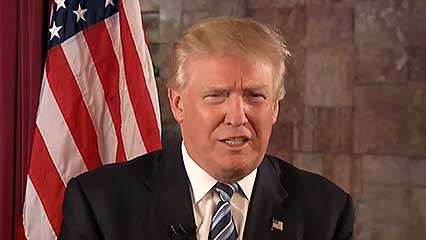

Almost immediately upon taking office, Trump began issuing a series of executive orders designed to fulfill some of his campaign promises and to project an image of swift, decisive action. His first order, signed on his first day as president, directed that all “unwarranted economic and regulatory burdens” imposed by the ACA should be minimized pending the “prompt repeal” of that law. Five days later he directed the secretary of the Department of Homeland Security to begin planning for the construction of a wall along the country’s southern border. An executive order on ethics imposed a five-year ban on “lobbying activities” by former executive branch employees but weakened or removed some lobbying restrictions imposed by the Obama administration.
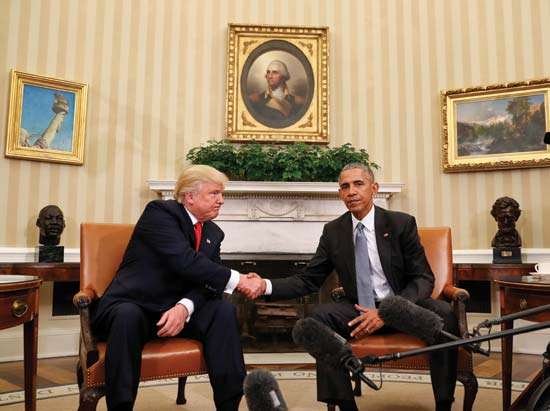

Trump, Donald; Obama, Barack
Pres. Barack Obama (right) and President-elect Donald Trump in the Oval Office of the White House, Washington, D.C., November 10, 2016.
Pablo Martinez Monsivais/AP Images

in full Donald John Trump, (born June 14, 1946, [New York,](https://www.britannica.com/place/New-York-City) New York, U.S.), 45th [president of the United States](https://www.britannica.com/topic/presidency-of-the-United-States-of-America) (2017– ). Trump was also a real-estate developer who amassed vast hotel, [casino,](https://www.britannica.com/topic/casino-gambling-house) golf, and other properties in the New York City area and around the world.
Politics
- Trump was active in politics. From the 1980s he periodically mused in public about running for president, but those moments were widely downplayed in the press as publicity stunts. In 1999 he switched his voter registration from Republican to the Reform Party and established a presidential exploratory committee. Though he ultimately declined to run in 2000, he set forth his socially liberal and economically conservative political views in The America We Deserve (2000). Trump later rejoined the Republican Party, and he maintained a high public profile during the 2012 presidential election. Though he did not run for office at that time, he gained much attention for repeatedly questioning whether Pres. Barack Obama was a natural-born U.S. citizen.
In June 2015 Trump announced that he would be a candidate in the U.S. presidential election of 2016. Pledging to “make America great again,” he promised to create millions of new jobs, to punish American companies that exported jobs overseas, to repeal the Affordable Care Act (ACA), to revive the U.S. coal industry, to “drain the swamp” in Washington, D.C., by reducing the influence of lobbyists, to withdraw the United States from the 2015 Paris Agreement on climate change, to construct a wall along the U.S.-Mexico border to prevent illegal immigration from Latin America, and to ban immigration by Muslims. Trump wrote about those and other issues in Crippled America: How to Make America Great Again (2015).
- On the campaign trail, Trump quickly established himself as a political outsider, a stance that proved popular with many voters—especially those in the Tea Party movement—and he frequently topped opinion polls, besting established Republican politicians. However, his campaign was frequently mired in controversy, much of it of his own making. In speeches and via Twitter, a social medium he used frequently, Trump often made inflammatory remarks, some of which were deemed offensive, especially to Mexicans, Muslims, and women. Trump’s initial refusal to condemn the Ku Klux Klan after a former Klansman endorsed him also drew sharp criticism, as did his failure to repudiate racist elements among his supporters in the “alt-right” (a loose association of self-described white nationalists, far-right libertarians, and neo-Nazis). While Trump’s comments worried the Republican establishment, supporters seemed to be pleased by his combativeness, his provocative language, and his outsider status. After a loss in the Iowa caucuses to open up the primary season in February 2016, Trump rebounded by winning the next three contests, and he extended his lead with a strong showing on Super Tuesday—when primaries and caucuses were held in 11 states—in early March. After a landslide victory in the Indiana primary in May, Trump became the presumptive Republican nominee as his last two opponents, Ted Cruz and John Kasich, dropped out of the race.

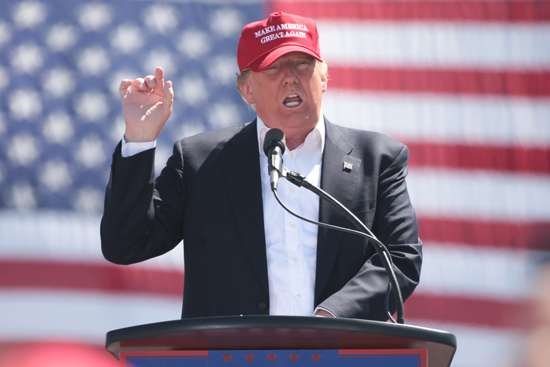
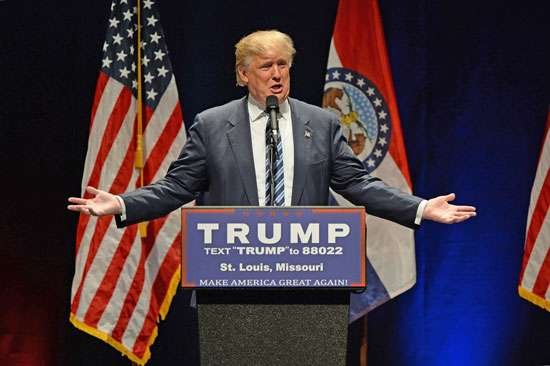

In July 2016 Trump announced that Indiana Gov. Mike Pence would be his vice presidential running mate. At the Republican National Convention the following week, Trump was officially named the party’s nominee. There he and other speakers harshly criticized the presumptive Democratic nominee, former secretary of state Hillary Clinton, blaming her for the 2012 attack on the U.S. consulate in Benghazi, Libya, and for allegedly having mishandled classified State Department e-mails (an FBI investigation determined earlier in July that her actions had been “extremely careless” but not criminal). Trump continued that theme in the ensuing weeks, routinely referring to Clinton as “crooked Hillary” and repeatedly vowing to put her in jail if he were elected.
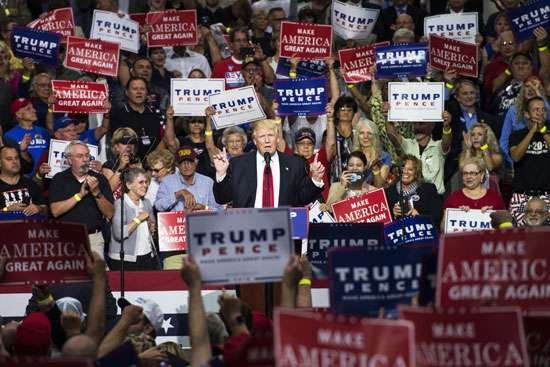

Trump, Donald: 2016 U.S. presidential campaign
Donald Trump at a rally in Akron, Ohio, August 2016.
Amy Harris—Rex Features/Shutterstock/AP Images

- Despite having pledged in 2015 that he would release his tax returns, as every presidential nominee of a major party had done since the 1970s, Trump later changed his mind, explaining that he was under routine audit by the Internal Revenue Service (IRS)—though there was no legal bar to releasing his returns under audit.
In late July, on the eve of the Democratic National Convention, thousands of internal e-mails of the Democratic National Committee (DNC) were publicly released by the Web site WikiLeaks in an apparent effort to damage the Clinton campaign. Reacting to widespread suspicions that the e-mails had been stolen by Russian hackers, Trump publicly encouraged the Russians to hack Clinton’s private e-mail server to find thousands of e-mails that he claimed had been illegally deleted.
- Following the Democratic convention, Trump continued to make controversial and apparently impromptu comments via Twitter and in other forums that embarrassed the Republican establishment and seriously disrupted his campaign. He drew particular criticism for a series of negative comments about women, and in October 2016 a hot-mic video from 2005 surfaced in which he told an entertainment reporter that he had tried to seduce a married woman and that “when you’re a star…you can do anything,” including grabbing women by the genitals. Although Trump dismissed the conversation as “locker room talk,” a series of women subsequently claimed that Trump had sexually assaulted them in the past. He denied the allegations and noted that Bill Clinton had previously been accused of sexual assault and harassment. However, Trump’s support among women voters—already low—continued to wane, and some Republicans began to withdraw their endorsements.
- Approximately one hour after the release of the Trump video, WikiLeaks published a trove of e-mails that had been stolen from the account of John Podesta, Clinton’s campaign manager. On the same day, the U.S. intelligence community publicly announced its assessment that the Russian government had directed efforts by hackers to steal and release sensitive Democratic Party e-mails and other information in order to bolster the Trump campaign and weaken public confidence in U.S. electoral institutions. In response, Trump questioned the competence and motives of U.S. intelligence agencies and insisted that no one really knew who might have been behind the hacking. A secret CIA report to Congress in December and a separate report ordered by Obama and released in January 2017 also concluded that the Russians had interfered in the election.
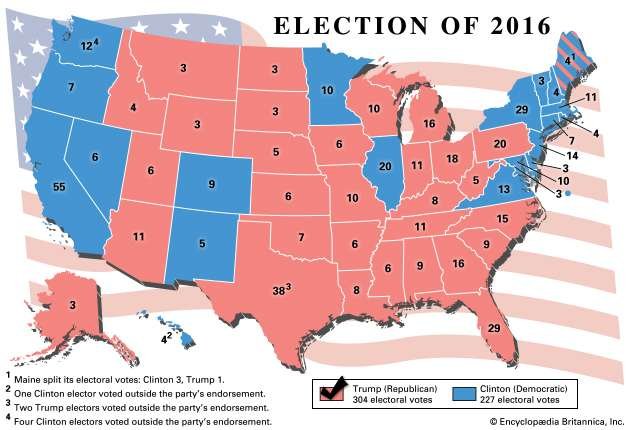

United States presidential election of 2016
Results of the U.S. presidential election, 2016.
Encyclopædia Britannica, Inc.

Despite his ongoing efforts to portray Clinton as “crooked” and an “insider,” Trump trailed her in almost all polls. As election day neared, he repeatedly claimed that the election was “rigged” and that the press was treating him unfairly by reporting “fake news.” He received no endorsements from major newspapers. During the third and final presidential debate, in October, he made headlines when he refused to say that he would accept the election results.
Eight days after that debate, the Trump campaign received a boost when FBI director James Comey notified Congress that the bureau was reviewing a trove of e-mails from an unrelated case that appeared to be relevant to its earlier investigation of Clinton. Trump seized on the announcement as vindication of his charge that Clinton was crooked. Six days later, Comey announced that the new e-mails contained no evidence of criminal activity. Notwithstanding the damage that Comey’s revelation had done to her campaign, Clinton retained a slim lead over Trump in the polls of battleground states on the eve of election day, and most pundits and political analysts remained confident that she would win. When voting proceeded on November 8, 2016, however, Trump bested Clinton in a chain of critical Rust Belt states, and he was elected president. Although Trump won the electoral college vote by 304 to 227, and thereby the presidency, he lost the nationwide popular vote by more than 2.8 million. (After the election, Trump claimed without evidence that 3 to 5 million people had voted for Clinton illegally.) Trump took the oath of office on January 20, 2017.
Trump’s unexpected victory prompted much discussion in the press regarding the reliability of polls and the strategic mistakes of the Clinton campaign. Most analysts agreed that Clinton had taken for granted some of her core constituencies (such as women and minorities) and that Trump had effectively capitalized upon the economic anxieties and resentment of working-class whites, particularly men.

